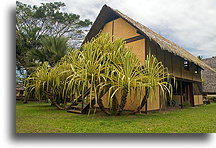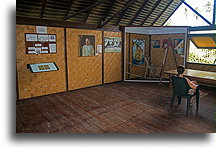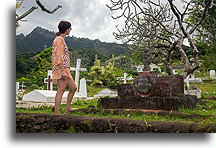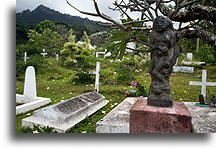The French painter Paul Gauguin spent the last years of his life on Hiva Oa on the Marquesas. After traveling to Panama and Martinique, time spent in France, Gauguin went to Tahiti and Hiva Oa in French Polynesia. After arriving to Hiva Oa, Gauguin became friendly with the local bishop. By ingratiated himself to attend mass regularly he gained priests’ favor that allowed him to buy a plot of land in the center of Otuona. On his plot, Gauguin built a two-floor house. The walls of his studio were decorated with his collection of nude photographs he purchased on his way from France. Over time, Gauguin’s lifestyle and young women around him as his muse have sparked bishop’s criticism. Antipathy became mutual. To express his feelings, Gauguin carved two sculptures lampooning the bishop and his servant commonly reputed as bishop’s mistress and placed them at the foot of the stairs to his house. We found the sculpture of the bishop, Père Paillard on display at the National Gallery of Art in Washington D.C, in the United States.



Primitive societies attracted Gauguin. His art was inspired by the severity and simplicity of the so-called primitive art of foreign cultures. Gauguin was the first artist to achieve public success using techniques based on Primitivism as a movement in art. In private life, he was a constant seeker of pleasure and found European morals constraining. The Polynesian women attracted him especially. His life motto was, “Be in love, you will be happy”. The house he built in Atuona was named “House of Pleasure”. Paul Gauguin had many children with many young women. He died in 1903 and is buried on Hiva Oa.


Paul Gauguin's last will was to place his own bronze sculpture called Oviri on the grave. In Tahitian mythology, Oviri was the goddess of mourning. It seems that Gauguin's artistic interpretation of this goddess was based on the mummified skulls of the Marquesas Islands and bas-reliefs from Borobudur in Java, Indonesia.




